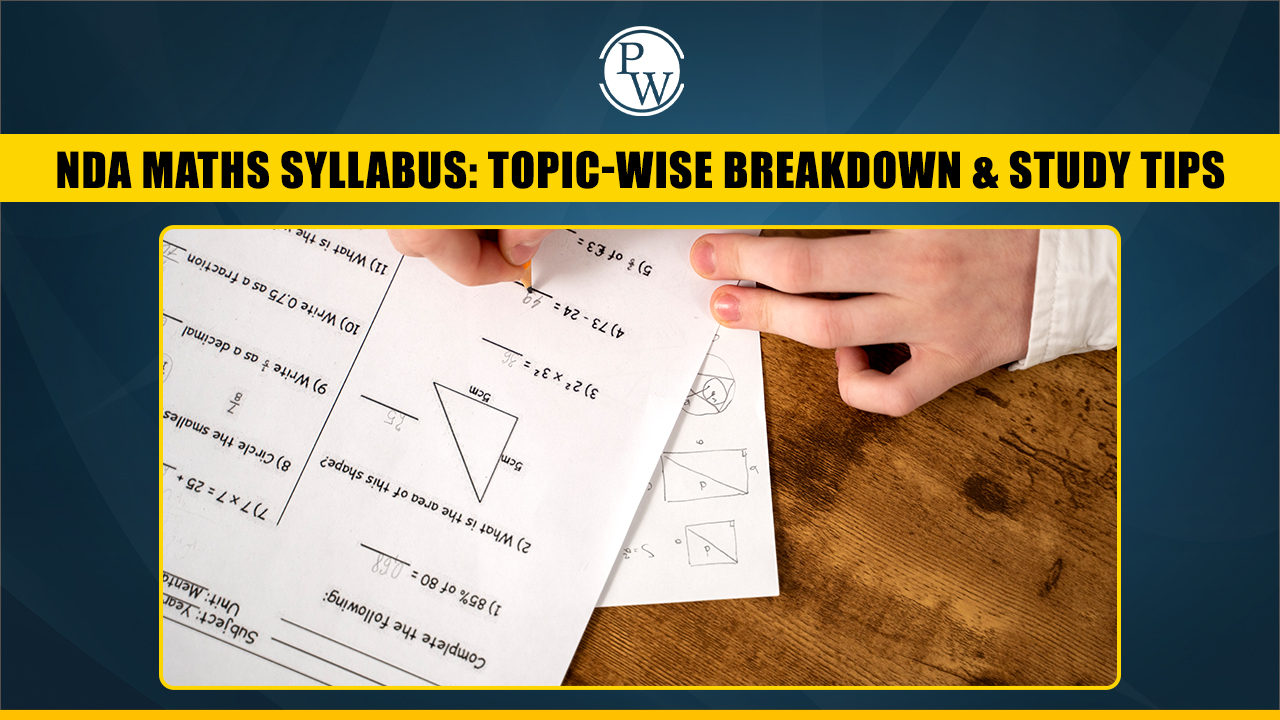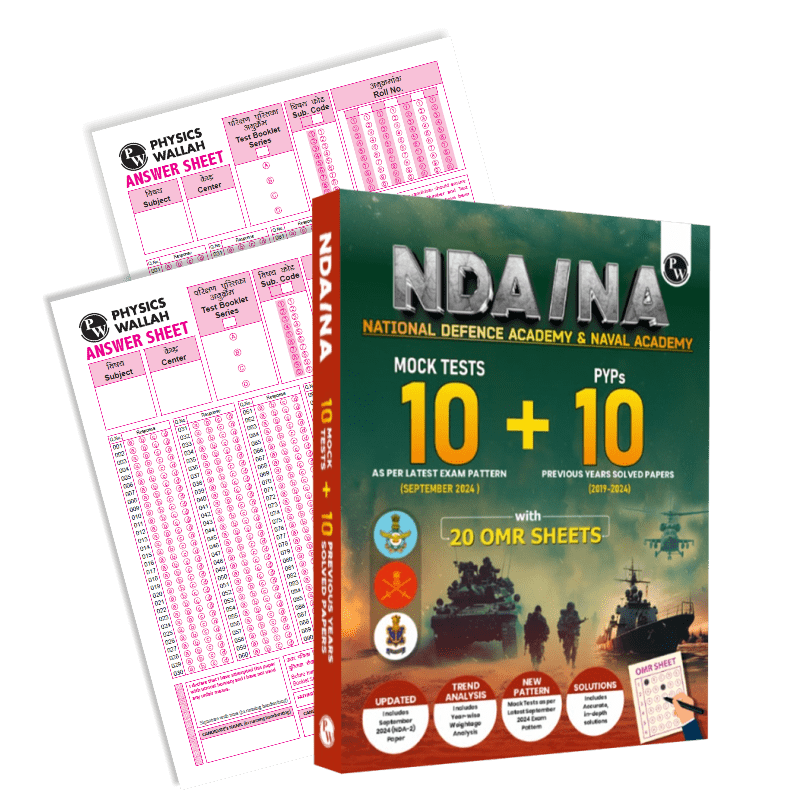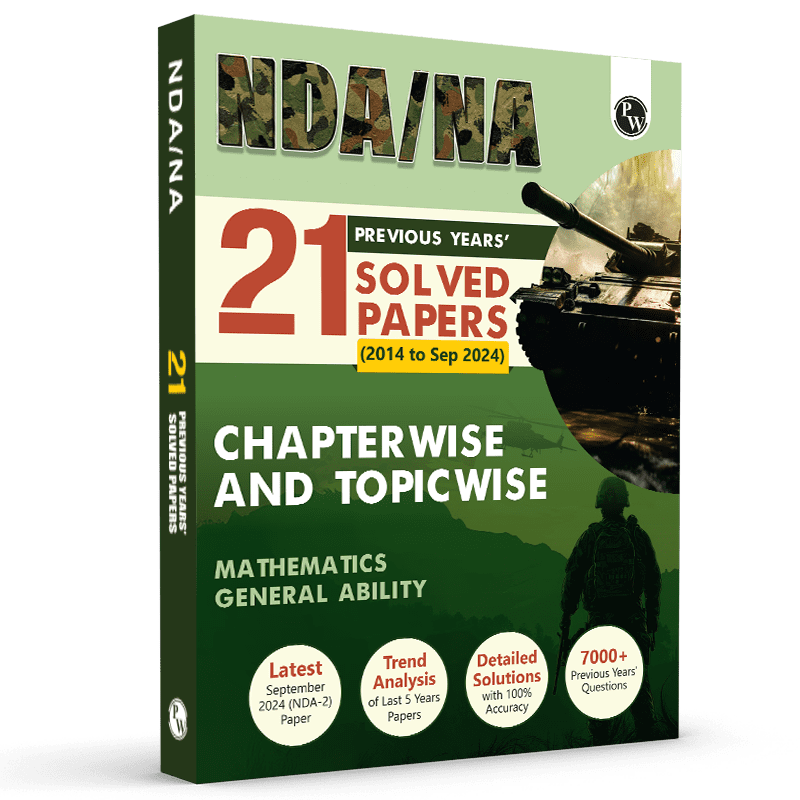NDA Maths Syllabus: Topic-wise Breakdown & Study Tips

The NDA Maths Syllabus plays a crucial role in the National Defence Academy (NDA) exam, which is a gateway to joining the Indian Army, Navy, and Air Force. It covers a wide range of mathematical topics, including algebra, calculus, geometry, trigonometry, and statistics. A solid grasp of these concepts is essential for scoring well in the NDA exam 2025.
This article provides a detailed breakdown of the NDA Maths Syllabus, highlighting key topics and offering study tips to help you prepare effectively. Understanding the syllabus and focusing on important areas will make your preparation more organized and efficient. With the right approach and practice, mastering the NDA Maths Syllabus is crucial to achieving success in the NDA exam and securing a spot in the prestigious National Defence Academy.
Check out: NDA/Defence Books
NDA Maths Syllabus
The NDA Maths Syllabus is an essential part of the National Defence Academy (NDA) exam, focusing on various mathematical concepts and their practical applications. Below is a detailed breakdown of the NDA Maths Syllabus, highlighting the key topics and sub-topics that candidates need to focus on for effective preparation.
|
Topics |
Sub-Topics |
|
Algebra |
- Sets, Venn diagrams, De Morgan laws, Cartesian product, relation, equivalence relation. - Real numbers, Complex numbers, Modulus, Cube roots, Conversion of a number in Binary system to Decimals and vice-versa. - Arithmetic, Geometric and Harmonic progressions. - Quadratic equations, Linear inequations, Permutation and Combination, Binomial theorem and Logarithms. |
|
Calculus |
- Concept of a real-valued function, domain, range and graph of a function. - Composite functions, one to one, onto and inverse functions. - Notion of limit, Standard limits, Continuity of functions, algebraic operations on continuous functions. - Derivative of function at a point, geometrical and physical interpretation of a derivative-application. - Derivatives of sum, product and quotient of functions, derivative of a function with respect to another function, derivative of a composite function. - Second order derivatives. - Increasing and decreasing functions. - Application of derivatives in problems of maxima and minima. |
|
Matrices and Determinants |
- Types of matrices, operations on matrices. - Determinant of a matrix, basic properties of determinants. - Adjoint and inverse of a square matrix, Applications-Solution of a system of linear equations in two or three unknowns by Cramer’s rule and by Matrix Method. |
|
Integral Calculus and Differential Equations |
- Integration as inverse of differentiation, integration by substitution and by parts, standard integrals involving algebraic expressions, trigonometric, exponential and hyperbolic functions. - Evaluation of definite integrals—determination of areas of plane regions bounded by curves-applications. - Definition of order and degree of a differential equation, formation of a differential equation by examples. - General and particular solution of differential equations, solution of first order and first-degree differential equations of various types—examples. - Application in problems of growth and decay. |
|
Trigonometry |
- Angles and their measures in degrees and in radians. - Trigonometric ratios. - Trigonometric identities Sum and difference formulae. - Multiple and Sub-multiple angles. - Inverse trigonometric functions. - Applications-Height and distance, properties of triangles. |
|
Vector Algebra |
- Vectors in two and three dimensions, magnitude, and direction of a vector. - Unit and null vectors, the addition of vectors, scalar multiplication of a vector, scalar product, or dot product of two vectors. - Vector product or cross product of two vectors. - Applications—work done by a force and moment of a force and in geometrical problems. |
|
Analytical Geometry of Two and Three Dimensions |
- Rectangular Cartesian Coordinate system, Distance formula, Equation of a line in various forms. - The angle between two lines. - Distance of a point from a line. - Equation of a circle in standard and in a general form. - Standard forms of parabola, ellipse, and hyperbola. - Eccentricity and axis of a conic. - Point in a three-dimensional space, the distance between two points. - Direction Cosines and direction ratios. - Equation two points. - Direction Cosines and direction ratios. - Equation of a plane and a line in various forms. - Angle between two lines and angle between two planes. - Equation of a sphere. |
|
Statistics and Probability |
- Probability: Random experiment, outcomes, and associated sample space, events, mutually exclusive and exhaustive events, impossible and certain events. - Union and Intersection of events. - Complementary, elementary, and composite events. - Definition of probability—classical and statistical—examples. - Elementary theorems on probability-simple problems. - Conditional probability, Bayes’ theorem—simple problems. - Random variable as function on a sample space. - Binomial distribution, examples of random experiments giving rise to Binomial distribution. |
Check out: NDA Mock Test + PYQs
NDA Maths Syllabus: Topic-wise Breakdown & Study Tips
The NDA Maths Syllabus is one of the most important and challenging parts of the NDA Exam. This section, which forms a significant portion of the written exam, assesses candidates’ understanding of mathematical concepts, problem-solving skills, and ability to apply those concepts under time pressure. The NDA Maths Syllabus comprises various topics that span from algebra and calculus to geometry, trigonometry, and statistics. To help you prepare efficiently, we have outlined a detailed NDA Maths Syllabus breakdown and essential study tips.
1. Algebra in NDA Maths Syllabus
Algebra forms the foundation of many problems in the NDA Maths Syllabus. It includes the basics of equations, inequalities, and expressions.
-
Understand the Basics: Focus on mastering the fundamental algebraic concepts, as they form the basis for advanced topics in the NDA Maths Syllabus.
-
Practice Solving Equations: The more you practice solving equations, the faster you'll become. This will help you solve problems more efficiently during the exam.
2. Calculus in NDA Maths Syllabus
Calculus is a crucial topic in the NDA Maths Syllabus, contributing to several questions in the exam. The calculus section includes limits, differentiation, and integration.
-
Clear the Concepts: Make sure you understand the basic principles of limits and derivatives before moving to more complex topics.
-
Use NCERT: For integration and differentiation, NCERT textbooks are an excellent resource to build your understanding of these core topics.
3. Trigonometry in NDA Maths Syllabus
Trigonometry is a key component of the NDA Maths Syllabus, with many questions focusing on angles, identities, and functions.
Study Tips for Trigonometry:
-
Master Trigonometric Identities: These are vital for solving trigonometric problems. Make sure you memorize all important identities.
-
Practice Problems: Regularly practice solving trigonometric equations and problems on heights and distances to gain accuracy.
4. Geometry in NDA Maths Syllabus
Geometry is another major area of the NDA Maths Syllabus, testing your understanding of shapes, angles, and properties.
-
Visualize Shapes: Geometry involves a lot of visual learning. Always try to draw figures and solve problems using diagrams.
-
Understand Theorems: Make sure you thoroughly understand the important geometric theorems and their proofs to tackle questions efficiently.
5. Statistics & Probability in NDA Maths Syllabus
Statistics and Probability are also important parts of the NDA Maths Syllabus, testing your understanding of data analysis and probability concepts.
-
Work with Data: Practice solving problems that involve data interpretation and calculation of measures of central tendency.
-
Focus on Probability: This section can be tricky, so solve as many probability problems as possible to strengthen your understanding.
6. NDA Maths Syllabus: Time Management Tips
Time management is key to tackling the NDA Maths syllabus effectively. Since the mathematics paper in the NDA exam is time-bound, improving your speed and accuracy is essential.
Study Tips:
-
Practice Under Time Pressure: Simulate real exam conditions by practising questions within the time limits.
-
Set Targets: Divide your study time based on the weightage of each topic in the NDA Maths Syllabus. Set targets for each study session and stick to them.
Check out:
- NDA NA 21 Previous Years Solved Papers Book
- UPSC NDA/NA 10 Previous Year Solved Papers & 10 Mock Tests Book
NDA Maths Syllabus 2024 FAQ
How many topics are covered in the NDA Maths Syllabus?
The NDA Maths Syllabus is extensive and covers more than 10 core topics. Key areas include Algebra, Calculus, Trigonometry, Vector Algebra, and Analytical Geometry, among others. Each topic is subdivided into several subtopics.
How do I handle tough topics in the NDA Maths Syllabus?
For tough topics, break them down into smaller subtopics and tackle them one by one. Practice as much as possible, and don’t hesitate to seek help from teachers or online resources if needed. Focus on strengthening your weak areas gradually.
Is the NDA Maths exam difficult for beginners?
The difficulty of the NDA Maths exam can vary depending on your mathematical background. However, with consistent preparation, regular practice, and proper understanding of the syllabus, even beginners can perform well in the exam.










